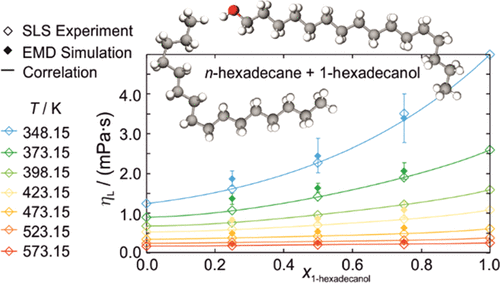当前位置:
X-MOL 学术
›
J. Chem. Eng. Data
›
论文详情
Our official English website, www.x-mol.net, welcomes your
feedback! (Note: you will need to create a separate account there.)
Viscosity, Interfacial Tension, and Density of Binary-Liquid Mixtures of n-Hexadecane with n-Octacosane, 2,2,4,4,6,8,8-Heptamethylnonane, or 1-Hexadecanol at Temperatures between 298.15 and 573.15 K by Surface Light Scattering and Equilibrium Molecular Dynamics Simulations
Journal of Chemical & Engineering Data ( IF 2.0 ) Pub Date : 2021-04-28 , DOI: 10.1021/acs.jced.1c00108 Frances D. Lenahan 1 , Michael Zikeli 1 , Michael H. Rausch 1 , Tobias Klein 1 , Andreas P. Fröba 1
Journal of Chemical & Engineering Data ( IF 2.0 ) Pub Date : 2021-04-28 , DOI: 10.1021/acs.jced.1c00108 Frances D. Lenahan 1 , Michael Zikeli 1 , Michael H. Rausch 1 , Tobias Klein 1 , Andreas P. Fröba 1
Affiliation

|
This work contributes to the characterization of three binary liquid hydrocarbon-based mixtures via the determination of density, viscosity, and interfacial tension over the entire concentration range up to temperatures of 573.15 K. The oscillating-tube method, surface light scattering (SLS), and equilibrium molecular dynamics (EMD) simulations are applied to analyze the influences of chain length, branching, and hydroxylation on the aforementioned thermophysical properties. For probing these effects, the three binary systems of n-hexadecane (1) with n-octacosane (2), 1-hexadecanol (2), or 2,2,4,4,6,8,8-heptamethylnonane (2), each with mole fraction of x1 = 0.25, 0.5, or 0.75, are investigated in macroscopic thermodynamic equilibrium at or close to saturation conditions at temperatures between 298.15 and 573.15 K. Based on the experimental results for the liquid densities, liquid viscosities, and interfacial tensions with average expanded uncertainties (k = 2) of 0.10, 2.0, and 1.8%, respectively, our previously published modification to the optimized potentials for the liquid simulations (OPLS) force field for long hydrocarbons (L-OPLS) is evaluated for its transferability to liquid mixtures in EMD simulations. Considering all simulation results, the average absolute relative deviations for the density, viscosity, and interfacial tension are 0.74, 27, and 14%, respectively. Experimental results are also applied for the evaluation of simple prediction models based on pure-component properties. Especially at high temperatures, such simple mixing rules perform well. At lower temperatures, however, nonidealities like surface enrichment or the formation of molecule clusters in the mixture are more likely to dominate fluid behavior, leading to a failure of the simple mixing rules. To explain this observation, partial-density profiles and radial distribution functions from simulations, giving access to the fluid structure on a microscopic level, are evaluated.
中文翻译:

粘度,界面张力,和二元-液体混合物的密度Ñ十六烷与Ñ在温度298.15和573.15 K内由表面之间-Octacosane,2,2,4,4,6,8,8-七甲基壬烷,或1-十六光散射和平衡分子动力学模拟
这项工作可通过测定高达573.15 K的整个浓度范围内的密度,粘度和界面张力,对三种二元液态烃基混合物的表征做出贡献。振荡管法,表面光散射(SLS),平衡分子动力学(EMD)模拟用于分析链长,支链和羟基化对上述热物理性质的影响。为了探测这些效应,使用了正十六烷(1)与正十八烷(2),1-十六醇(2)或2,2,4,4,6,8,8-庚甲基壬烷(2)的三个二元系统,每个摩尔分数为x 1在298.15和573.15 K之间的温度或接近饱和条件下,在宏观热力学平衡条件下研究了0.25、0.5或0.75。基于平均密度不确定性(k的液体密度,液体粘度和界面张力的实验结果)= 2)分别为0.10%,2.0%和1.8%,我们先前针对长碳氢化合物(L-OPLS)的液体模拟(OPLS)力场优化电位潜力发表的修改版在EMD模拟中评估了其向液体混合物的转移性。考虑所有模拟结果,密度,粘度和界面张力的平均绝对相对偏差分别为0.74、27和14%。实验结果也可用于基于纯组分特性的简单预测模型的评估。特别是在高温下,这种简单的混合规则表现良好。然而,在较低的温度下,诸如表面富集或在混合物中形成分子簇之类的非理想现象更可能主导流体行为,从而导致简单的混合规则失效。
更新日期:2021-05-13
中文翻译:

粘度,界面张力,和二元-液体混合物的密度Ñ十六烷与Ñ在温度298.15和573.15 K内由表面之间-Octacosane,2,2,4,4,6,8,8-七甲基壬烷,或1-十六光散射和平衡分子动力学模拟
这项工作可通过测定高达573.15 K的整个浓度范围内的密度,粘度和界面张力,对三种二元液态烃基混合物的表征做出贡献。振荡管法,表面光散射(SLS),平衡分子动力学(EMD)模拟用于分析链长,支链和羟基化对上述热物理性质的影响。为了探测这些效应,使用了正十六烷(1)与正十八烷(2),1-十六醇(2)或2,2,4,4,6,8,8-庚甲基壬烷(2)的三个二元系统,每个摩尔分数为x 1在298.15和573.15 K之间的温度或接近饱和条件下,在宏观热力学平衡条件下研究了0.25、0.5或0.75。基于平均密度不确定性(k的液体密度,液体粘度和界面张力的实验结果)= 2)分别为0.10%,2.0%和1.8%,我们先前针对长碳氢化合物(L-OPLS)的液体模拟(OPLS)力场优化电位潜力发表的修改版在EMD模拟中评估了其向液体混合物的转移性。考虑所有模拟结果,密度,粘度和界面张力的平均绝对相对偏差分别为0.74、27和14%。实验结果也可用于基于纯组分特性的简单预测模型的评估。特别是在高温下,这种简单的混合规则表现良好。然而,在较低的温度下,诸如表面富集或在混合物中形成分子簇之类的非理想现象更可能主导流体行为,从而导致简单的混合规则失效。











































 京公网安备 11010802027423号
京公网安备 11010802027423号